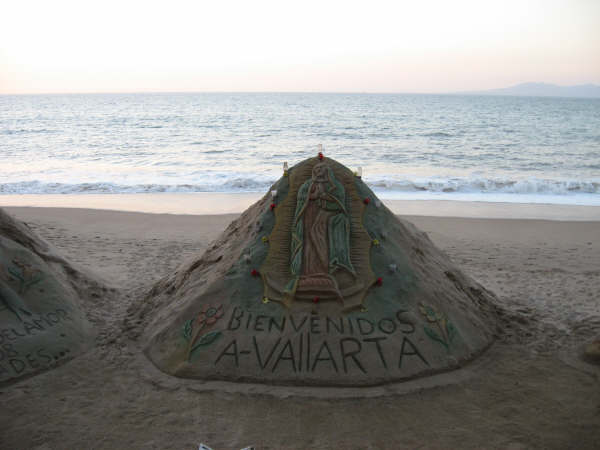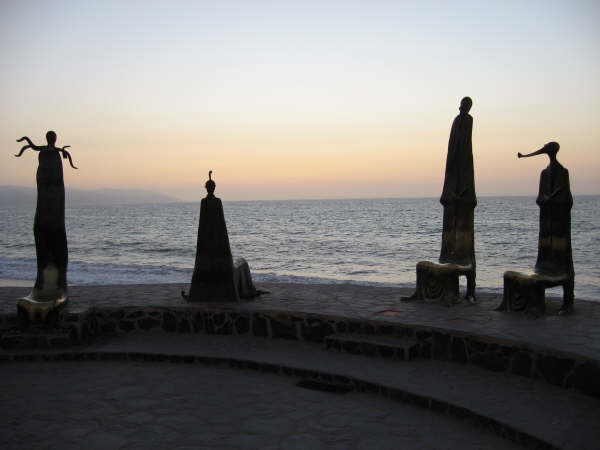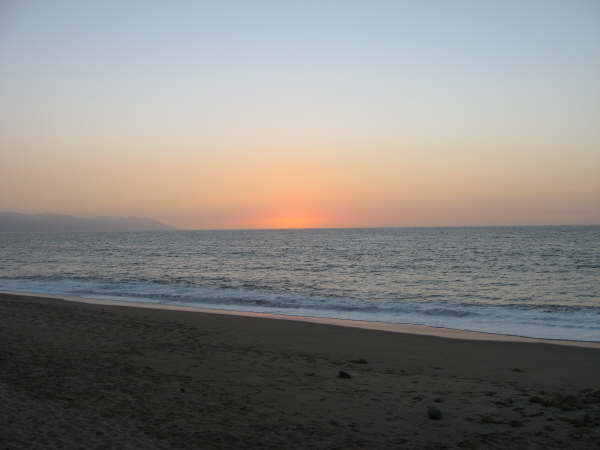Exploring Puerto Vallarta, Mexico
Cultural Life Beyond the Beach
Article and photos by Veronica Hackethal

|
|
A welcoming beach sand castle in Puerto Vallarta, Mexico with a religious theme.
|
Unlikely as this may sound, I was looking for novelty and booked a trip to Puerto Vallarta. I grew up in a family who, for financial and other reasons (there were five kids), did not vacation. Since then, I have traveled widely, but this was my first trip to a resort. Before arriving, I had imagined Puerto Vallarta to be Cancun transplanted to the Pacific coast. I was prepared for cruise-ship day trippers, spring break groupies, even Canadian snowbirds hastily developing melanoma. But on first impression, I had to admit: Puerto Vallarta is beautiful. Here, bougainvilleas burst with fluorescent blooms and ocean breezes gently caress. Here, cliffs descend dramatically to the sea and outline the port in a jagged blue picture frame. Here, whales and dolphins swim so close you can see them from the shore. Time (for visitors) drips away like honey.
But like a rose (whose beauty includes thorns), Puerto Vallarta has many layers, whose unfurling began on the second day. While roaming the beach and admiring the cool blue Pacific sparkling endlessly into the distance, a man offering horseback rides tried to pick me up. He was deeply tanned and clad in the regulation white of the town’s beach hawkers. I replied in halting Spanish, to his surprise. Maybe it was because I had not ignored him or reacted angrily, as he seemed to expect. Or maybe it was because I knew Spanish beyond “No gracías” or “Un otra bebida por favor.” “De donde eres?” He said (still trying to pick me up). “Los Angeles,” I replied.”Si? Tengo família allá,” he continued. We started the jossle of figuring out where the other is really from (common to L.A., where many people live in commuter towns encompassed by the city’s urban sprawl). “Soy de Rialto,” I admitted, which lies fifty-five miles east of LA and where half the population is Mexican. More surprise. “Tengo família en Lytle Creek,” he said, a town ten minutes’ drive from where I grew up. Suddenly, this place didn’t feel so far from Southern California. Maybe it was the Sheraton Bougainvilleas snuggling next to a flimsily built shelter where chickens roamed, but I felt confused.
Puerto Vallarta’s History
Everyday Mexico, with its beauty and contradictions, nips at the edges of Puerto Vallarta, and it is hard to ignore. That night in the Centro, I wandered narrow cobble-stoned streets and found remnants of the sleepy fishing village Puerto Vallarta once was. This place felt unexpectedly complicated, and I wanted to know more.
Since its early days Puerto Vallarta was about money, and it still is. Unlike Cancun, though, the resort was not founded solely for tourism. Puerto Vallarta started out as a Mexican town, and still retains parts of this identity. Early visitors recognized the beauty of its coastline and the economic potential of the Bay of Banderas (one of the largest natural bays in the world). In the 16th century, Spanish soldiers re-supplied their ships here. They also built a shipyard for constructing vessels used in the colonization of Lower California. In the 18th century, the area became a rich resource for whaling (the Bay of Banderas was also called Humpback Bay), and fishing (still important today).
During the 19th century, the town remained an isolated fishing village. Originally called Las Peñas, it provided shipping to the agricultural and silver mining centers in the Sierras (Cuale, San Sebastian, and Mascota). Attracted by Puerto Vallarta’s natural beauty, families from the Sierra towns began vacationing here. Legend has it that Puerto Vallarta was founded in 1851 (the same year as Seattle) by Don Guadalupe Sanchez Torres when he brought his family permanently to the settlement. In 1918, the Mexican government officially recognized the town as a municipality. Its name was changed to Puerto Vallarta in memory of Jalisco’s governor (Don Ignacio L. Vallarta), and it stuck.
During WWII, Puerto Vallarta found a new source of wealth in sharks fished from its bay. Shark fins from the Bay of Banderas ended up on the tables of New York’s Chinese restaurants, and shark liver oil was used as a nutritional supplement for US soldiers. At this time, a few national and international tourists began trickling in. But the town’s isolation continued to hamper tourism. In 1954, Air Mexicana started the Guadalajara- Puerto Vallarta flight, making the town more accessible. Not until 1963, however, with the arrival of John Huston’s film crews for the shooting of Tennessee Williams’ “Night of the Iguana” did tourism pick up. For awhile Puerto Vallarta became a mecca for the international jet set. Then the town slipped off the style map and became a stop-over on the Baja cruise circuit. Too bad, I thought as I peeked into La Iglesia de Nuestra Senora de Guadalupe (the patron saint of Puerto Vallarta). Those who do not take their time here miss out.
The Economy
Deep in thought, I rounded the corner into the green glow of Señor Frog’s (it is advisable to wear shades when passing). No doubt about it, Puerto Vallarta is one of Mexico’s top tourist destinations. Tourism accounts for roughly half of the town’s economic activity. The bay is 3rd in cruise ship arrivals in Mexico and brings in more than $US35 million annually. There is a contradiction, though: the Mexican navy maintains a military base just outside of town. More reality: tourism in Mexico is big business. Tourism brings in over 10 million visitors spending billions of dollars (8.5% of GDP) and helps to support millions of jobs. Behind oil, and remittance from Mexicans living abroad, tourism is the major source of foreign currency inflow.
About half of Puerto Vallarta’s work force is employed in tourism, but the industry is not the only source of livelihood. Venturing outside the resorts reveals a surrounding countryside dotted with banana farms in the Ameca valley, mango farms in the low hills, and avocado farms in the higher ground above the city. Livestock in the Ameca valley and fishing in the Bay of Banderas still provide important contributions to the town’s economy. And of course, tourist development provides ample work for a strong construction sector (at least 10% of the workforce).
Discovering this information made me uneasy. I am not an economist, but it seems like this setup could make local residents dependent on the whims of foreign currency (not an original observation, as analysts of Latin American markets may tell you). I wondered: is Puerto Vallarta just a haven for foreign tourists profiting from underpaid locals? Perhaps, but in my hotel Mexican families were also piling plates high at the breakfast buffet. On my 3rd night, a parade of vintage motorcars rumbled into town. Candy-apple red roadsters with Jalisco plates parked along the Malecon (boardwalk), their owners standing proudly beside. Puerto Vallarta is a popular spot for weekend getaways by residents of nearby Guadalajara (tapatíos). The city is especially popular for domestic tourists during Semana Santa (Holy Week, one of the most important holiday periods in Latin America), and during Christmas.

|
|
The beach town center at sunset with modern statues in Puerto Vallarta.
|
Poverty in Puerto Vallarta
The fourth night, I danced salsa at La Bodeguita del Medio, a Cuban place near the malecon. On the rafters above someone had written “Lucía es feliz y yo tambien, gracías a la vida”. My middle name is Lucia, and at that moment I felt the same: happy. But my dance partner’s hands were calloused. From what? Beyond the high rise luxury resorts, poverty exists in Puerto Vallarta. Drawn by Puerto Vallarta’s employment opportunities, many end up living in poorly served areas like Las Ramblas or La Bucería. As late as 2000, most of the roads in Las Ramblas (which had 45,000 permanent dwellings at that time) were in poor condition. 10% of these roads were unpaved; 8% of the dwellings had no connections to a sewer system (residents used pits or dumped sewage directly into waterways); 10% had no potable water supply (residents used water from a public tap); and 4% had no electricity.
To Puerto Vallarta’s credit, these problems have been noticed. Perhaps having historical roots helps maintain the town’s sense of community, or maybe the tourist surplus contributes, but it is not without a conscience. A recent building boom resulted in the construction of low income housing which at least provides basic facilities. Numerous charities have also sprung up. Tourism funds many of their works.
The Rise of Charities
Like many of life’s events, the new charitable activities often center around food, which is very good in Puerto Vallarta. The town is one of Mexico’s gourmet capitals, where some of the country’s top chefs have set up shop. Here, I tried huitlacoche for the first time. Known as Mexican truffle, it is a fungus that grows on damp corn. Getting past the name’s translation (“raven’s excrement” in Nahuatl) was a hurdle, but it tasted so good I wanted more. Had it been November, when the town hosts the Festival Gourmet International Mexico-Riviera Nayar, I might have eaten much, much more. During this time, Puerto Vallarta becomes a forum that showcases, supports, and encourages the evolution of Mexican culinary traditions. In its thirteenth year, this event features celebrity chefs from over 20 local restaurants, as well as international celebrity chefs. Past years have featured Chef Patricia Quintana, the First Lady of Mexican cuisine.
Charities draw on the town’s culinary talent to raise money. In the fall, the city hosts the Fifth Annual Palomazo Culinario (Culinary Jam Session for Charity), during which chefs from Puerto Vallarta’s top restaurants cook together to help local charities with benefits raising over $US18,000. 100% of the proceeds were donated equally to AGAPE (a shelter for young girls who have been molested or abused), Arturos y los hijos de dios (aid to individuals and families in crisis), Becas Vallarta (scholarships to young Vallartans), and Asilo de Ancianos San Juan Diego (elderly home).
For the last five years, the Marriott Casa Magna has hosted the International Altruism Festival. Held in May, chefs from local restaurants and 50+ local companies join together in a culinary and cultural festival that raised $US 50,000. All proceeds went equally to 20 local charities. Other charities in Puerto Vallarta include Vallarta Enfrenta el SIDA (Vallarta Against AIDS), Amigos de Bucerías (works to improve the water supply, roads, and other buildings in Bucerías), the Refugio Infantil Santa Esperanza, Grupo Ecologico Puerto Vallarta, and the Consejo de Proteccion y Conversación de las Tortugas Marinas (Sea Turtle Rescue Program, whose efforts helped remove the golfina turtle from the endangered species list).
My last night, I wandered along the malecon to watch the sunset. From a street stand I bought soft tacos, almost too hot to eat and filled with succulent, spicy beef. At the other end of the malecon, I bought horchata and grilled corn rubbed with lime and chile from more street stands illuminated in the soft glow of lights strung overhead. In the calming rays of the fading day, I wondered: without tourism, would Puerto Vallarta’s layers exist? Maybe not these layers, maybe not here, but would they grow someplace else? The contradictions of this place confuse me: a paradise for some, but not for others. How much of Puerto Vallarta exists to justify privileged indulgence? Would it be ignoring one important part of Mexico not to know about the role of tourism, as well as Puerto Vallarta’s community improvement efforts? What is worse, an imperfect solution or denial? I do not have an answer.
For more information see the Charities and NGOs based in Puerto Vallarta according to the local BanderasNEWS.com.

|
|
A stunning end to a sunset at a beach in Puerto Vallarta.
|
Veronica Hackethal has lived in a hut on the African savannah, worked in a hospital in Guatemala City, made a half circle of the Mediterranean from Morocco to Turkey, slept under the stars in the Australian outback, and gotten her rental car stuck in the capillaries of a mountain top village in Sicily. She is originally from Los Angeles and studied anthropology at Harvard and Oxford universities. She currently lives and writes in New York City.
|
